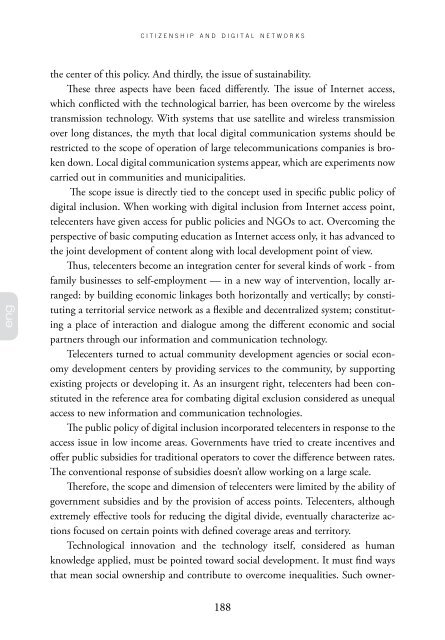Sergio Amadeu da Silveira - Cidadania e Redes Digitais
Sergio Amadeu da Silveira - Cidadania e Redes Digitais
Sergio Amadeu da Silveira - Cidadania e Redes Digitais
You also want an ePaper? Increase the reach of your titles
YUMPU automatically turns print PDFs into web optimized ePapers that Google loves.
eng<br />
c i t i z e n s h i p a n d d i g i t a l n e t w o r k s<br />
the center of this policy. And thirdly, the issue of sustainability.<br />
These three aspects have been faced differently. The issue of Internet access,<br />
which conflicted with the technological barrier, has been overcome by the wireless<br />
transmission technology. With systems that use satellite and wireless transmission<br />
over long distances, the myth that local digital communication systems should be<br />
restricted to the scope of operation of large telecommunications companies is broken<br />
down. Local digital communication systems appear, which are experiments now<br />
carried out in communities and municipalities.<br />
The scope issue is directly tied to the concept used in specific public policy of<br />
digital inclusion. When working with digital inclusion from Internet access point,<br />
telecenters have given access for public policies and NGOs to act. Overcoming the<br />
perspective of basic computing education as Internet access only, it has advanced to<br />
the joint development of content along with local development point of view.<br />
Thus, telecenters become an integration center for several kinds of work - from<br />
family businesses to self-employment — in a new way of intervention, locally arranged:<br />
by building economic linkages both horizontally and vertically; by constituting<br />
a territorial service network as a flexible and decentralized system; constituting<br />
a place of interaction and dialogue among the different economic and social<br />
partners through our information and communication technology.<br />
Telecenters turned to actual community development agencies or social economy<br />
development centers by providing services to the community, by supporting<br />
existing projects or developing it. As an insurgent right, telecenters had been constituted<br />
in the reference area for combating digital exclusion considered as unequal<br />
access to new information and communication technologies.<br />
The public policy of digital inclusion incorporated telecenters in response to the<br />
access issue in low income areas. Governments have tried to create incentives and<br />
offer public subsidies for traditional operators to cover the difference between rates.<br />
The conventional response of subsidies doesn’t allow working on a large scale.<br />
Therefore, the scope and dimension of telecenters were limited by the ability of<br />
government subsidies and by the provision of access points. Telecenters, although<br />
extremely effective tools for reducing the digital divide, eventually characterize actions<br />
focused on certain points with defined coverage areas and territory.<br />
Technological innovation and the technology itself, considered as human<br />
knowledge applied, must be pointed toward social development. It must find ways<br />
that mean social ownership and contribute to overcome inequalities. Such owner-<br />
188


